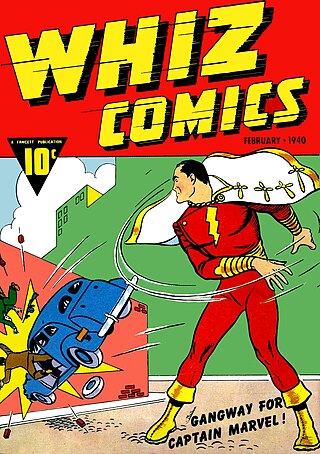
A superhero or superheroine is a stock character who typically possesses superpowers or abilities beyond those of ordinary people, is frequently costumed concealing their identity, and fits the role of the hero; typically using their powers to help the world become a better place, or dedicating themselves to protecting the public and fighting crime. Superhero fiction is the genre of fiction that is centered on such characters, especially, since the 1930s, in American comic books, as well as in Japanese media.
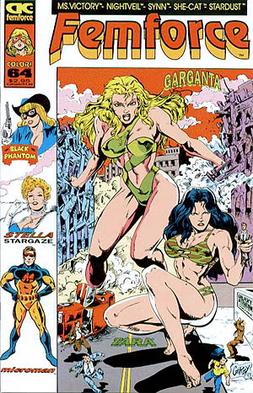
Femforce is a comic book published by AC Comics that began publication in 1985, detailing the adventures of the titular team: the "Federal Emergency Missions Force" or "Femforce", some of them original creations, while others originated in the 1940s and 1950s, lapsing into the public domain by the time Femforce was published. The team are, as their name implies, all superheroines, and are the first and the longest running all-women 'super-team'. The series has passed 200 issues, a significant milestone for an independent comic book company. Writers on the book have included Bill Black, Stephanie Sanderson, Mark Heike, Paul Monsky, Enrico Teodorani and Francesca Paolucci. Artists on the book have included Bill Black, Stephanie Sanderson, Mark Heike, Brad Gorby, Jeff Austin, Dave Roberts and Rik Levins.
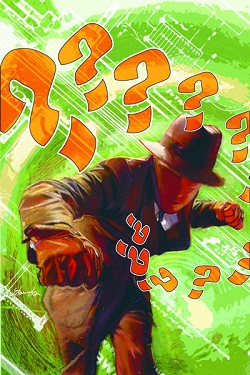
The Question is a name used by several fictional characters appearing in American comic books published by DC Comics. Created by Steve Ditko, the Question first appeared in Charlton Comics' Blue Beetle #1, and was acquired by DC Comics in the early 1980s and incorporated into the DC Universe.
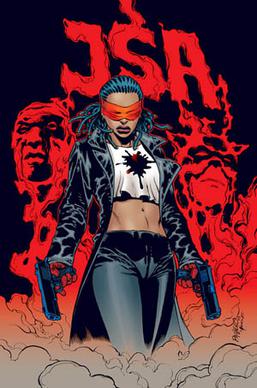
The Crimson Avenger is the name of three separate superheroes and supervillains in the DC Comics Universe. The character debuted in 1938 and is notable as the first masked hero in DC Comics.
AC Comics is a comic book publishing company started by Bill Black.

Miss America is a superhero appearing in American comic books published by Marvel Comics. Created by writer Otto Binder and artist Al Gabriele, the character first appeared in Marvel Mystery Comics #49 in the Golden Age of Comic Books. Madeline Joyce is the first incarnation of Miss America. The character has also been a member of the Invaders, Liberty Legion, and All-Winners Squad at various points in her history.

Phantom Lady is a fictional superheroine appearing in media published by Quality Comics and DC Comics. She was created by the Eisner & Iger studio, one of the first to produce comics on demand for publishers. The character's early adventures were drawn by Arthur Peddy.
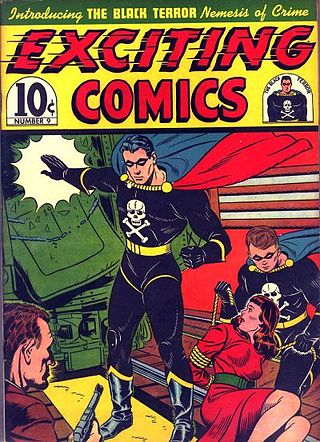
The Black Terror is a fictional comic book superhero debuting in Exciting Comics #9, published by Nedor Comics in January 1941. The character was popular and, on the strength of the Black Terror's sales, Nedor made Exciting Comics a monthly magazine starting with issue #11.
Spider Widow is a fictional superhero character that was published by Quality Comics during the Golden Age of Comic Books. The character was created by writer and artist Frank Borth, and debuted in Feature Comics #57, which bore a cover date of June 1942. Borth continued to write and draw the Spider Widow feature until the end of its run in Feature Comics #72.

Cat-Man and Kitten are a pair of fictional superhero characters created by artists Irwin Hasen (Cat-Man) and Charles M. Quinlan (Kitten) with unknown writers. Cat-Man was first published in 1940 by various Frank Z. Temerson companies. Due to circumstances during World War II, an altered version of Cat-Man was published in Australia and reprinted in the 1950s. AC Comics later revived the characters in the 1980s.

Daredevil is a fictional superhero created by Jack Binder, who starred in comics from Lev Gleason Publications during the 1930s–1940s period that historians and fans call the Golden Age of comic books. The character was retroactively established into the Image Universe by Image Comics in the 1990s as its first character. The character is unrelated to Marvel Comics' Daredevil, and recent renditions of the character have often renamed him Doubledare or The Death-Defying Devil to avoid confusion and potential lawsuits.
Centaur Publications was one of the earliest American comic book publishers. During their short existence, they created several colorful characters, including Bill Everett's Amazing-Man.

The Fighting Yank is the name of several superheroes, first appearing in Startling Comics #10.
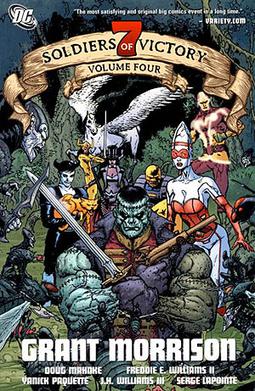
Seven Soldiers is a 2005–2006 comic book metaseries written by Grant Morrison and published by DC Comics. It was published as seven interrelated mini-series and two bookend issues. The series features a new version of the Seven Soldiers of Victory fighting to save Earth from the Sheeda. The series has been interpreted as "an extended metafictional treatise on the writing and reading of comic books in general and the superhero genre in particular".
Sentinels of Justice is a fictional organization of superheroes. The comic was published by Americomics in 1983 during a very brief time that AC was able to license the Charlton Comics superheroes before the rights were purchased outright by DC Comics. The team consisted of Captain Atom, Blue Beetle, the Question and Nightshade. This line-up's first appearance was in Americomics Special #1. A revised team made up of existing Americomics characters Captain Paragon, Nightveil, Stardust, Commando D, and Scarlet Scorpion would appear in Captain Paragon and the Sentinels of Justice #1–3 (1985–86), the title would change to Sentinels of Justice with #4, it would last until issue #6 (1986).

Blue Ribbon Comics is the name of two American comic book anthology series, the first published by the Archie Comics predecessor MLJ Magazines Inc., commonly known as MLJ Comics, from 1939 to 1942, during the Golden Age of Comic Books. The revival was the second comic published in the 1980s by Archie Comics under the Red Circle and Archie Adventure Series banners.

The Lady Liberators, also called the Liberators, is a superhero team appearing in American comic books published by Marvel Comics. The original team's only appearance was in Avengers volume 1 #83, written by Roy Thomas, with art by John Buscema and Tom Palmer. The original team was a one-off group, lasting only a single issue and meant to satirize what was perceived to be extreme feminism, though it is also now seen as an early example of the Scarlet Witch as a feminist character.

The Woman in Red is a fictional character that first appeared in the period known to comic book historians as the Golden Age of Comic Books. Created by writer Richard E. Hughes and artist George Mandel, she first appeared in Thrilling Comics #2, published by Nedor Comics. The character was later revived by writer Alan Moore for America's Best Comics. She would also be used by Dynamite Entertainment in Project Superpowers Chapter Two.
Night Man is a superhero television series, developed by Glen A. Larson, that aired in syndication from September 15, 1997, to May 17, 1999. The series is loosely based on the character from the 1993 The Night Man comic book published, through the Ultraverse imprint, by Malibu Comics, and was created by writer Steve Englehart, who also wrote three episodes of the series.














